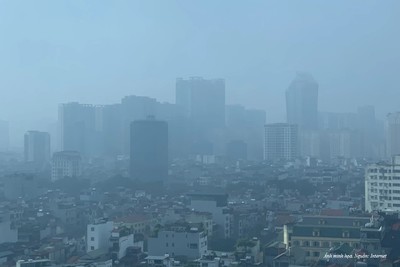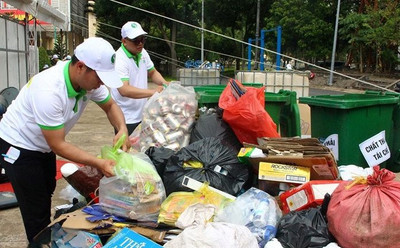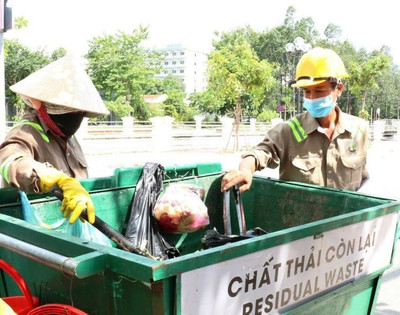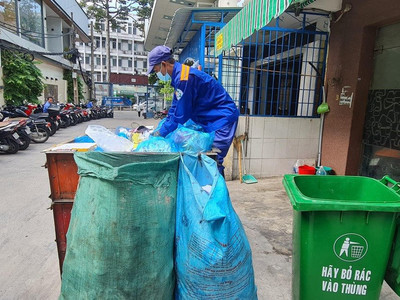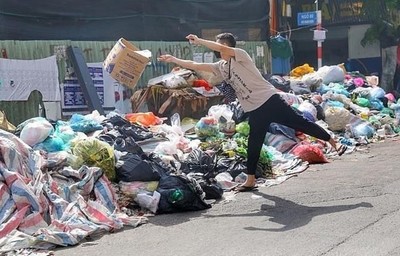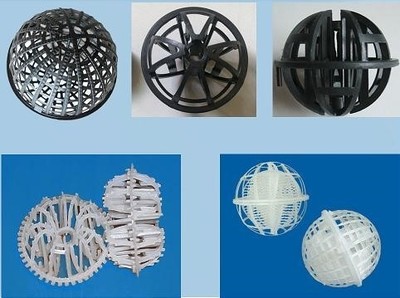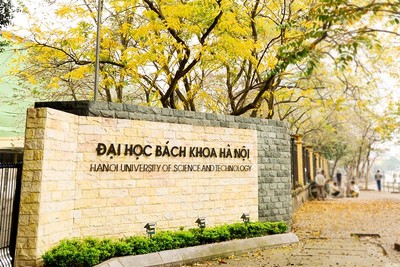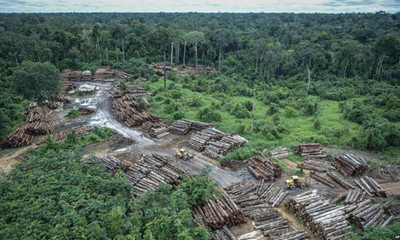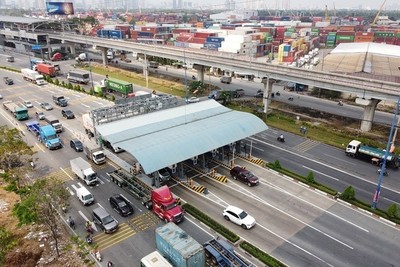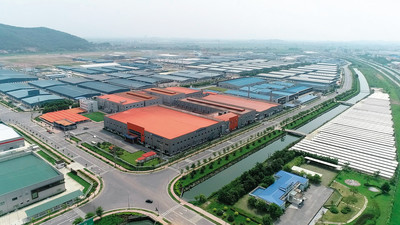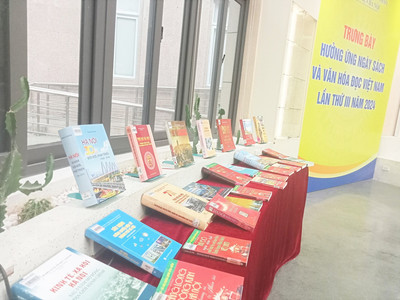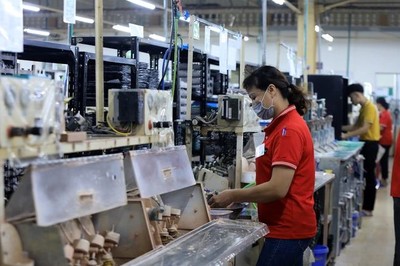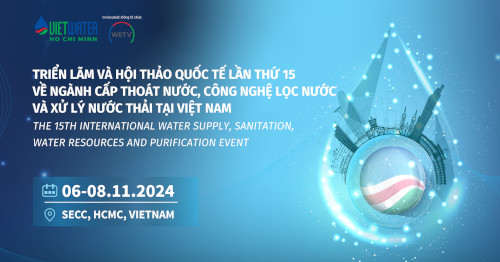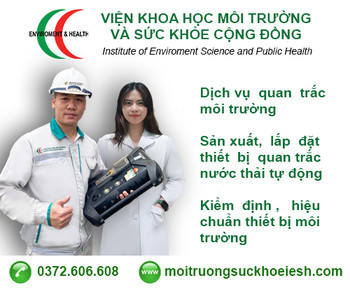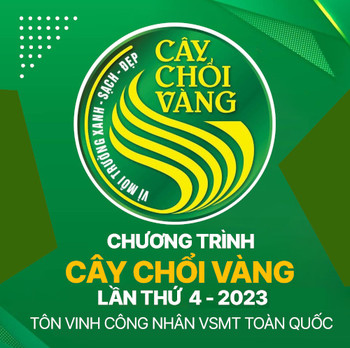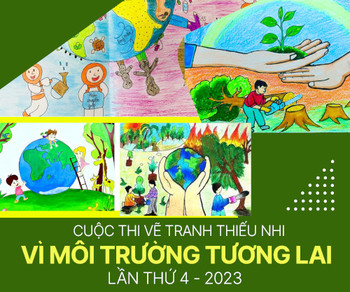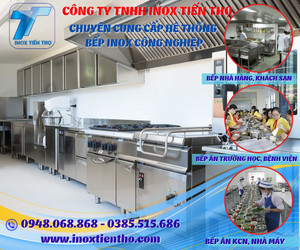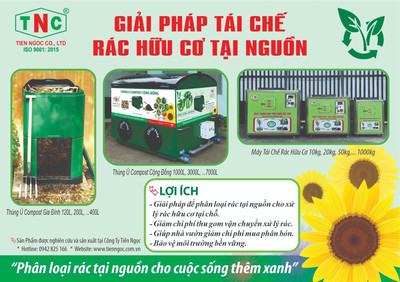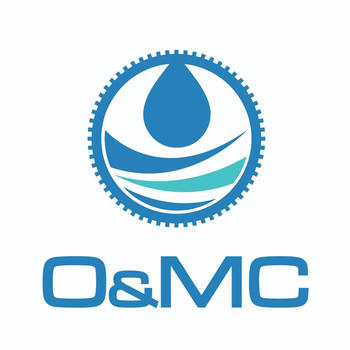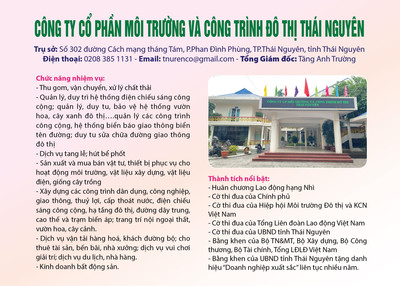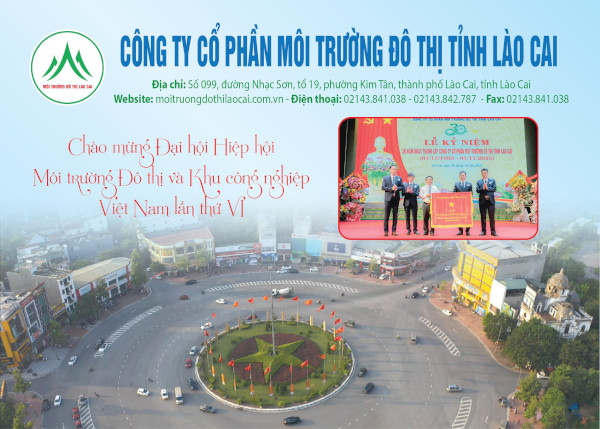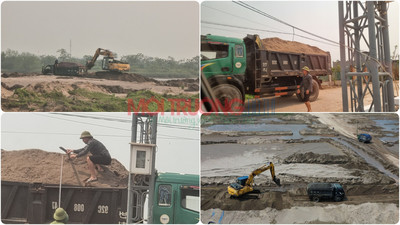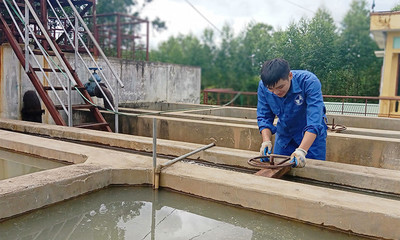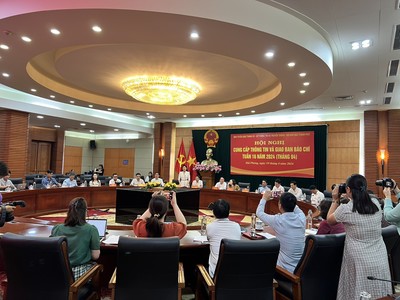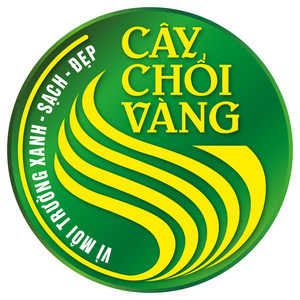Công bố quốc tế lĩnh vực môi trường số 12-2023
Trân trọng giới thiệu tới quý độc giả Công bố quốc tế lĩnh vực môi trường số 12-2023 với những nội dung chính như sau:
Về quản lý môi trường
- Liệu đầu tư trực tiếp nước ngoài có thúc đẩy hoạt động môi trường: Một cuộc điều tra về chi phí ẩn của các chất gây ô nhiễm
- Tác động của đa dạng trang trại đối với sản xuất lương thực, tạo thu nhập và bảo tồn môi trường: Trường hợp của Thụy Sĩ
- Các mô hình hành vi môi trường giữa các cụm quốc gia thuộc Liên minh Châu Âu: Khám phá sự không đồng nhất trong mối quan hệ thái độ-hành vi-bối cảnh
- Đánh giá toàn diện về quản lý thiết bị điện và điện tử đã qua sử dụng, tập trung vào hoạch định chính sách dựa trên nền kinh tế tuần hoàn
- Xác định các quốc gia có ảnh hưởng trong công nghệ kiểm soát ô nhiễm không khí: Phương pháp phân tích mạng lưới xã hội
- Các trụ cột về môi trường, xã hội và quản trị nào có thể cải thiện hiệu quả hoạt động mua bán và sáp nhập?
- Sự tham gia mạnh mẽ vào môi trường, xã hội và quản trị có gây ra rủi ro cho công ty không? Vai trò điều tiết của bồi thường điều hành
- Đổi mới trong các doanh nghiệp vừa và nhỏ sản xuất trong đại dịch COVID-19: Sự năng động về môi trường củng cố hành vi chủ động của nhân viên như thế nào?
- Việc sử dụng các phương pháp tiếp cận mới để đánh giá rủi ro môi trường của thực phẩm và hóa chất thức ăn chăn nuôi
- Phân tích đầu vào-đầu ra mở rộng về mặt môi trường phác thảo hiệu quả các kế hoạch chuyển đổi môi trường quy mô lớn: Minh họa của ngành đường bộ Canada
Về môi trường đô thị
- Tác động của sol khí đô thị đối với hoạt động ngưng tụ trên đám mây bằng mô hình phân cụm
- Tương tác của HRT vận hành và nhiệt độ đối với sự tắc nghẽn của màng cấp ba xử lý nước thải đô thị
- Đánh giá thành phần hóa học liên quan đến giao thông trong hạt siêu mịn và hạt mịn tại các đô thị Việt Nam
- Phát thải khí nhà kính, hạt vật chất và các hợp chất hữu cơ dễ bay hơi trong tương lai từ việc đốt chất thải rắn đô thị ở Ấn Độ
- Đánh giá hiệu suất của bộ lọc nhỏ giọt cải tiến và quy trình bùn hoạt tính thông thường cùng với xử lý bậc ba trong việc loại bỏ các chất ô nhiễm mới nổi ra khỏi nước thải đô thị
- Nồng độ cơ bản, phân bổ nguồn và đánh giá rủi ro xác suất của kim loại nặng trong bụi đường phố đô thị ở Đông Bắc Brazil
- Sự xuất hiện của các chất ô nhiễm gây lo ngại mới nổi ở sông Eerste, Nam Phi: Hướng tới việc tối ưu hóa phương pháp tiếp cận lập hồ sơ nước đô thị để mô tả đặc điểm rủi ro sức khỏe cộng đồng và sinh thái
- Xác định và mô tả tần suất và thời lượng tối đa của nhiệt đô thị bề mặt và đảo mát trên khắp các thành phố toàn cầu
- Ảnh hưởng theo mùa đến chỉ số ô nhiễm và rủi ro của nhiều thành phần hạt vi nhựa trong sông đô thị
- Đại dịch COVID-19 có làm thay đổi hành vi quản lý thực phẩm của các hộ gia đình và hành vi lãng phí thực phẩm không? Một thử nghiệm tự nhiên sử dụng đối sánh điểm xu hướng
Về môi trường khu công nghiệp
- Tìm hiểu cơ chế hấp phụ và cố định kim loại nặng của than sinh học rơm ngô hydroxit kép phân lớp CaFe: Tổng hợp và ứng dụng trong môi trường ô nhiễm kim loại nặng tổng hợp
- Sàng lọc không nhắm mục tiêu cho thấy ethoxylate fluorotelomer trong bụi trong nhà và nước thải công nghiệp
- Nước thải công nghiệp làm tăng nguy cơ kháng kháng sinh trong môi trường ven biển
- Các yếu tố độc hại tiềm ẩn trong tóc da đầu của con người xung quanh khu vực khai thác và luyện quặng đất hiếm đa kim lớn nhất Trung Quốc
- Bình xịt sinh học trong khu công nghiệp và nhà liền kề: Sự phân tán giữa trong nhà/ngoài trời, tác động của máy lọc không khí và giảm thiểu rủi ro sức khỏe
- Cố định bùn lọc công nghiệp độc hại bằng mayenite và thạch cao
- So sánh các quy tắc phân bổ năng lượng cho hoạt động tự tiêu thụ tập thể trong lưới điện siêu nhỏ đa năng lượng công nghiệp
- Định hướng lại carbon thấp trong một ngành công nghiệp đang suy giảm? Phân tích theo chiều dọc về bối cảnh đồng phát triển và chiến lược của công ty trong ngành thép của Vương quốc Anh (1988–2022)
Xin trân trọng giới thiệu!
QUẢN LÝ MÔI TRƯỜNG
1. Does foreign direct investment promote environmental performance: An investigation on shadow prices of pollutants
Journal of Cleaner Production, Volume 387, 10 February 2023, 135914
Abstract
The shadow prices, or marginal abatement cost, of pollutants is a useful measure of environmental performance. Unlike much of the previous studies focusing on only one kind of pollutants, this paper applies the (multiplier) by-production approach to measure the shadow prices of carbon emission, sulfur emission, and dust. The case of regional economies in China is considered. As the foreign direct investment may have an impact on the environmental performance, a spatial Durbin model is utilized to identify the impact of foreign direct investment on the shadow prices of pollutants. The results show that the shadow prices of all three pollutants have been increasing over time which indicates the environmental performance of China has been improving. Moreover, the spatial regression results imply that both foreign direct investment and technology export volume positively impact the shadow price of pollutant emissions across the provinces of China.
2. Farm diversity impacts on food production, income generation and environmental preservation: The Swiss case
Journal of Cleaner Production, Volume 388, 15 February 2023, 135851
Abstract
A sample of 239 farm year observations of Swiss farms was assessed at the product group level for analyzing the relationship between environmental and economic performance and correlations between product groups (Milk, Cattle, Cereal, Beets, and Potatoes). The farms cover the production regions valley, hill and mountains and practice organic production or proof of ecological performance (PEP), the Swiss standard production.
The environmental dimension was covered by nine impact categories calculated by the Swiss Agricultural Life Cycle Assessment method (SALCA). The impacts were aggregated using a data envelopment analysis (DEA). The economic dimension is assessed by the family workforce income per product group calculated from a full cost data set from the Swiss farm accountancy data network (FADN). Hereby, all indirect costs, which cannot be directly attributed to the product groups, were allocated using standard costs.
We also included productivity as a third dimension in our analysis, quantified as output per area for crop products and output per animal livestock unit for the animal product groups.
No trade-offs between the environmental efficiency and the economic performance were identified. On the contrary, for Cattle and Milk we found significant synergies (1.5 times more observations show synergies than no effect or trade-offs).
Furthermore we found that productivity correlated positively with environmental efficiency for Milk (coefficient = 0.27), Cattle (coefficient = 0.38) and Cereals (coefficient = 0.30), but only for Cattle (coefficient = 0.17) and Potatoes (coefficient = 0.47) it correlated with economic performance.
For all product groups except Cereals, the organic farming system had 5% to 10 higher environmental efficiency and 5%–26% higher economic performance than the PEP farms. Although the differences were not significant, a consistent decrease up to −20% in environmental performance and productivity was observed between the valley/hill and the mountain region.
Our results show no indication that farmers maximize their productivity or economic performance at the cost of environmental efficiency. However, the large variability suggests that there is a) room for improvement in several dimension simultaneously, and b) that maximizing productivity does not seem to be a necessity for these improvements.
3. Environmental behavior patterns across clusters of European Union countries: Uncovering heterogeneity in the attitude-behavior-context relationship
Journal of Cleaner Production, Volume 388, 15 February 2023, 135936
Abstract
This study examines how European Union (EU) citizens systematically differ in their environmental attitude-behavior relationships according to country-level contextual drivers. Using Eurobarometer data and a multilevel latent class regression model, we identified four attitude-behavior relationships that we labelled, according to mean environmental behavior scores, as environmentalist, pre-environmentalist, less-environmentalist, and non-environmentalist. Regarding their distribution across the EU, we identified four country clusters reflecting pattern similarities that we labelled green, yellow-green, brown, and gray clusters. We found that the attitude-behavior relationship was weaker for more environmentalist patterns than for less environmentalist patterns. Furthermore, more environmentalist patterns were associated with more privileged social positions. As expected, the country clusters reflected socioeconomic development levels (more developed countries were environmentally greener). In the interest of reducing inequality in the distribution of environmentally healthy and vital ecosystems, we suggest that EU environmental policies should mainly address the environmental behaviors of countries classified as brown and gray.
4. A comprehensive review of used electrical and electronic equipment management with a focus on the circular economy-based policy-making
Journal of Cleaner Production, Volume 389, 20 February 2023, 136132
Abstract
In recent years, technological advancements have resulted in a proliferation of electrical and electronic equipment (EEE), accompanied by a rising massive amount of used electrical and electronic equipment (UEEE). Studies show that if transboundary flows of UEEE are carried out illegally, it can be one of the reasons for the increase in the volume of waste electrical and electronic equipment (WEEE) in developing countries, which necessitates urgent attention to the management of UEEE and WEEE. Toxic chemical components of WEEE can negatively impact ecosystems and human health and pose a severe threat to accomplishing sustainable development goals (SDGs). This review article provides an in-depth survey of UEEE and its differences from WEEE. UEEE is examined in detail to determine whether it is a potential toxic threat or a valuable source. If the transboundary flows of UEEE occur under legal regulations, it is a step toward a circular economy (CE), and the UEEE is recognized as a valuable resource. Otherwise, it is a potential threat to developing countries. Furthermore, the UEEE and WEEE are assessed from the perspective of international law, particularly the transboundary movement guidelines. In the following, the challenges in the transboundary flows of UEEE from developed to developing countries are mentioned. These challenges include a lack of inventory data, weak waste management policies and laws, expansion of the informal sector, and weak monitoring by law enforcement agencies for reliable environmental management. Finally, solutions to current challenges are presented. Undoubtedly, proper global management and legislation of UEEE and WEEE can help reduce the risks of e-waste and be the most effective way to achieve sustainable development goals.
5. Identifying influential countries in air pollution control technologies: A social network analysis approach
Journal of Cleaner Production, Volume 389, 20 February 2023, 136018
Abstract
Clarifying the spatial correlation network of country–level air pollution control technology (APCT) is essential for transregional collaborative emission reduction in global warming. Previous research mainly focused on identifying the network structures of green technology linkages in a single country or region. In reality, cross–border technological cooperation has become a strategy for countries to achieve technological breakthroughs, and non–adjacent countries can be interconnected. Based on 217,392 patents, this study uses the Social Network Analysis method and Quadratic Assignment Procedure to discuss the spatio-temporal evolution and influence mechanisms of 57 countries’ APCT spatial correlation network from 1990 to 2020. The results indicate the following: (1) The network density in APCT decreased from 0.428 to 0.355 between 1990 and 2020, and the overall network presents prominent core–periphery structural features. The developing countries accounted for 44.44% of the core area countries. (2) The United States and Canada, the United Kingdom, Germany, China, and Japan are at the center of the Americas, Europe, and Asia. (3) Narrowing the gap in greenhouse gas emissions in manufacturing industries and construction contributes to forming potential routes of multinational cooperation; however, the role of geographical distance becomes insignificant (0.282). Lastly, a multicenter knowledge flow network should facilitate global knowledge transfer, absorption, and sharing.
6. Which of environmental, social, and governance pillars can improve merger and acquisition performance?
Journal of Cleaner Production, Available online 22 February 2023, 136475
Abstract
The modern interdependent view of stakeholder theory suggests that the purpose of responsible sustainability is harmonious with the goal of maximizing profit. Especially, the social capital, built through sustainable investments, improves the firms’ resilience to shocks, such as mergers and acquisitions (M&A). Using a sample of 5255 novel American M&A, we examined the impact of sustainability measured in terms of environmental, social, and governance dimensions on M&A success using several econometric approaches. We found it is important for M&A success in long-term that acquirers fulfill social and environmental responsibility, although synergy might not appear immediately after an M&A due to the complexity of M&A operations. In addition, the result indicated that the social pillar (including the following drivers: human rights, working conditions, health and safety, and career development and training) is the most crucial sustainability dimension for improving M&A financial performance due to solving the problems of cultural friction and brain drain. This paper also outlines policy implications for managers, practitioners, other stakeholders, and future research.
7. Does aggressive environmental, social, and governance engagement trigger firm risk? The moderating role of executive compensation
Journal of Cleaner Production, Available online 20 February 2023, 136542
Abstract
Drawing on stakeholder and agency theories, we analyzed whether optimum and aggressive environmental, social, and governance engagement alleviates/exacerbates firm risk with the moderating effect of executive compensation. We distinguished optimum and aggressive environmental, social, and governance engagement via a separate research model and subsequently applied the generalized method of moments based on 43,803 observations between 2002 and 2019. We found that while optimum environmental, social, and governance engagement is negatively associated with firm risk, aggressive environmental, social, and governance engagement is positively associated with firm risk. However, the moderating effect of executive compensation significantly weakened the positive association between aggressive environmental, social, and governance engagement and firm risk. Hence, corporate social responsibility contracting is key to reconciling the interests of stakeholders and shareholders.
8. Innovation in manufacturing SMEs during the COVID-19 pandemic: How does environmental dynamism reinforce employee proactive behavior?
Technological Forecasting and Social Change, Volume 187, February 2023, 122247
Abstract
In a turbulent environment such as during the COVID-19 pandemic crisis, employee proactive behavior is imperative for innovation initiatives in small- and medium-sized enterprises (SMEs). We ask whether and how turbulent environments motivate employees to proactively engage in innovative behavior. This study argues that employees' perceptions of environmental dynamism reinforce employee proactive innovation behavior. Using a sample comprising 262 innovative employees from 40 manufacturing SMEs in Taiwan, this study tests a moderated-mediation model in which environmental dynamism is expected to increase the indirect effect of creative self-efficacy on employee innovative behavior through knowledge acquisition. The results confirm the mediating role of knowledge acquisition and the positive moderating effect of environmental dynamism. This study sheds light on the issue of employee proactive behavior in response to changing environments.
9. The use of new approach methodologies for the environmental risk assessment of food and feed chemicals
Current Opinion in Environmental Science & Health, Volume 31, February 2023, 100416
Abstract
New Approach Methodologies (NAMs) provide tools for supporting both human and environmental risk assessment (HRA and ERA). This short review provides recent insights regarding the use of NAMs in ERA of food and feed chemicals. We highlight the usefulness of tiered methods supporting weight-of-evidence approaches in relation to problem formulation (i.e., data availability, time, and resource availability). In silico models, including quantitative structure activity relationship models, support filling data gaps when no chemical property or ecotoxicological data are available, and biologically-based models (e.g., toxicokinetic-toxicodynamic models, dynamic energy models, physiologically-based models and species sensitivity distributions) are applicable in more data rich situations, including landscape-based modelling approaches. Particular attention is given to provide practical examples to apply the approaches described in real-world settings. We conclude with future perspectives, with regards to the need for addressing complex challenges such as chemical mixtures and multiple stressors in a wide range of organisms and ecosystems.
10. Environmentally-extended input-output analyses efficiently sketch large-scale environmental transition plans: Illustration by Canada's road industry
Journal of Cleaner Production, Volume 388, 15 February 2023, 136039
Abstract
Industries struggle to build robust environmental transition plans as they lack the tools to quantify their ecological responsibility over their value chain. Companies mostly turn to sole greenhouse gas (GHG) emissions reporting or time-intensive Life Cycle Assessment (LCA), while Environmentally-Extended Input-Output (EEIO) analysis is more efficient on a wider scale. We illustrate EEIO analysis' usefulness to sketch transition plans on the example of Canada's road industry: estimation of national environmental contributions, most important environmental issues, main potential transition levers of the sector, and metrics prioritization for green purchase plans. To do so, openIO-Canada, a new Canadian EEIO database, coupled with IMPACT World+ v1.30–1.48 characterization method, provides a multicriteria environmental diagnosis of Canada's economy. The construction sector carries the second-highest environmental impacts of Canada (8–31% depending on the indicator) after the manufacturing industry (20–54%). The road industry generates a limited impact (0.5–1.8%), and emits 1.0% of Canadians' GHGs, mainly due to asphalt mix materials (28%), bridges and engineering structures materials (24%), and direct emissions (17%). The industry must reduce the environmental burden from material purchases - mainly concrete and asphalt products - through green purchase plans and eco-design and invest in new machinery powered with cleaner energies such as low-carbon electricity or bioenergies. EEIO analysis also captures impacts often neglected in process-based pavement LCAs - amortization of capital goods, staff consumptions, and services – and shows some substantial impacts advocating for enlarging system boundaries in standard LCA. Yet, pavement construction and maintenance only explain 5% of the life cycle carbon footprint of Canada's road network, against 95% for the roads' usage (72% from vehicle tailpipes releases, 23% for manufacturing vehicles). Thereby, a carbon-neutral pathway for the road industry must first focus on reducing vehicle consumption and wear through better design and maintenance of roads. Finally, EEIO databases and analysis must be developed further as a powerful tool to fight planet degradation, and openIO-Canada must be specifically expanded and refined to allow for more robust and larger multicriteria assessments.
11. A critical review on slaughterhouse waste management and framing sustainable practices in managing slaughterhouse waste in India
Journal of Environmental Management, Volume 327, 1 February 2023, 116823
Abstract
Global meat consumption is on a rise with around 253 million metric tons of meat produced globally in the year 2020. Because of the rise in population and change in food preferences, meat consumption trend is likely to continue. Meat production by animal slaughtering increases the slaughterhouse wastes in the form of both solid and liquid wastes. Although various technologies for slaughterhouse waste management are available in developed countries, the effective utilization of slaughterhouse waste management is still missing in developing countries like India. India plays an active role in the meat export business globally and stood 2nd in the world with a total export valuation of 2.89 billion US $ in the year 2020. In this context, this study presents a critical overview of the current technological advancements in the global slaughterhouse waste management including utilization of by-products and further, the prevailing slaughterhouse waste management of India is discussed. Finally, a sustainable slaughterhouse waste management strategy emphasizing circular economy and regulations improvements have been suggested for India to compete in this sector at global scale.
12. Effect of urban form on PM2.5 concentrations in urban agglomerations of China: Insights from different urbanization levels and seasons
Journal of Environmental Management, Volume 327, 1 February 2023, 116953
Abstract
Planned urban form has become an important strategy to improve air quality in urban agglomerations (UAs), especially pollution due to PM2.5, but the influencing mechanisms are not yet clear. This study explores the relationship between four metrics of urban form (size, fragmentation, shape, and dispersion) as determined by analysis of remotely sensed images at 30-m resolution and PM2.5 concentrations in 19 Chinese UAs. The influence of level of urban development and season is examined. Five control variables, including population density, temperature, precipitation, wind speed, and the normalized difference vegetation index (NDVI) are selected for use in multiple linear regression models.
Size, fragmentation, and shape of urban form, but not dispersion, were found to have significant effects on PM2.5 concentrations of different urbanization-level UAs. Urban size and fragmentation have stronger impacts on PM2.5 concentrations in UAs with lower urbanization levels while urban shape has a greater impact in higher-level UAs. In terms of seasonal variation in all UAs, urban form is more pronouncedly associated with PM2.5 concentrations during spring and autumn than summer and winter.
Urban size and fragmentation are positively associated with PM2.5 concentrations whereas urban shape and dispersion are on the contrary. The relationships between urban form and PM2.5 uncovered here underscore the importance of urban planning as a tool to minimize PM2.5 pollution. Specifically, local government should encourage polycentric urban form with lower fragmentation in urban agglomerations. UAs with lower urbanization levels should control the disordered expansion of construction land and higher-level UAs should promote the mix of green land and construction land. Moreover, measures to control air pollution from anthropogenic activities in spring, autumn and winter are likely to be more effective in decreasing PM2.5 concentrations in UAs.
13. Secondary PM2.5 dominates aerosol pollution in the Yangtze River Delta region: Environmental and health effects of the Clean air Plan
Environment International, Volume 171, January 2023, 107725
Abstract
The Clean Air Plan has been active in China since 2013 to mitigate severe PM2.5 pollution. In this study, we applied the air quality model WRF-Chem to simulate PM2.5 in the Yangtze River Delta (YRD) region of China in 2017, with the aim of assessing the air quality improvement and its associated health burden in the final year of the Clean Air Plan. To better describe the fate of various PM2.5 compositions, we updated the chemical mechanisms in the model beforehand, including heterogeneous sulfate reactions, aqueous secondary organic aerosol (SOA) uptake, and volatility basis set (VBS) based SOA production. Both the observation and simulation results agreed that the stringent clear air action effectively reduced the PM2.5 pollution levels by ∼ 30 %. The primary PM2.5 (−6 ∼ − 16 % yr−1) showed a more significant decreasing trend than the secondary PM2.5 (−2 ∼ − 8 % yr−1), which was mainly caused by the directivity of the clear air actions and the worsening ozone pollution in the recent years. The inconsistent decreasing trends of PM2.5 components subsequently led to an increasing proportion of secondary PM2.5.
Nitrate particles, higher in the central and western YRD region, have replaced sulfate and have become the largest component of secondary inorganic aerosols year-round, except in summer, when strong ammonium nitrate evaporation occurs. In addition, SOA remains an important component (21 ∼ 22 %) especially in summer, most of which is produced from the oxidation and ageing of semi/intermediate volatile organic compounds (S/IVOC). Furthermore, we quantified the associated health impacts and found that the Clean Air Plan has largely reduced premature mortality due to PM2.5 exposure in the YRD region from 399.1 thousand to 295.7 thousand. Our study highlights the benefits of the Clean Air Plan and suggests that subsequent PM2.5 improvement should be geared more towards controlling secondary pollutants.
14. PM2.5 air pollution components and mortality in Denmark
Environment International, Volume 171, January 2023, 107685
Abstract
Background
Ambient fine particulate matter (PM2.5) causes millions of deaths every year worldwide. Identification of the most harmful types of PM2.5 would facilitate efficient prevention strategies.
Objectives
The aim of this study was to investigate associations between components of PM2.5 and mortality in a nation-wide Danish population.
Methods
Our study base was Danes born 1921–1985 and aged 30–85 years, who were followed up for mortality from 1991 to 2015. We included 678,465 natural cause mortality cases and selected five age, sex and calendar time matched controls to each case from the study base. We retrieved the address history of the study population from Danish registries and assessed five-year average concentrations of eight PM2.5 components using deterministic Chemistry-Transport Models air pollution models. We estimated mortality rate ratios (MRRs) by conditional logistic regression and adjusted for socio-demographical factors at individual and neighborhood level.
Results
Single pollutant models showed the strongest associations between natural cause mortality and an interquartile increase in sulfate particles (SO4−-) (MRR: 1.123; 95 % CI: 1.100–1.147 per 1.5 µg/m3) and secondary organic aerosol (SOA) (MRR: 1.054; 95 % CI: 1.048–1.061 per 0.050 µg/m3). Two-pollutant models showed robust associations between SO4−− and SOA and natural cause mortality. Elemental carbon and mineral dust showed robust associations with higher respiratory and lung cancer mortality.
Conclusion
This nation-wide study found robust associations between natural cause mortality and SO4−− particles and SOA, which is in line with the results of previous studies. Elemental carbon and mineral dust showed robust associations with higher respiratory and lung cancer mortality.
15. Air quality management strategies in Africa: A scoping review of the content, context, co-benefits and unintended consequences
Environment International, Volume 171, January 2023, 107709
Abstract
One of the major consequences of Africa’s rapid urbanisation is the worsening air pollution, especially in urban centres. However, existing societal challenges such as recovery from the COVID-19 pandemic, poverty, intensifying effects of climate change are making prioritisation of addressing air pollution harder.
We undertook a scoping review of strategies developed and/or implemented in Africa to provide a repository to stakeholders as a reference that could be applied for various local contexts. The review includes strategies assessed for effectiveness in improving air quality and/or health outcomes, co-benefits of the strategies, potential collaborators, and pitfalls.
An international multidisciplinary team convened to develop well-considered research themes and scope from a contextual lens relevant to the African continent. From the initial 18,684 search returns, additional 43 returns through reference chaining, contacting topic experts and policy makers, 65 studies and reports were included for final analysis.
Three main strategy categories obtained from the review included technology (75%), policy (20%) and education/behavioural change (5%). Most strategies (83%) predominantly focused on household air pollution compared to outdoor air pollution (17%) yet the latter is increasing due to urbanisation. Mobility strategies were only 6% compared to household energy strategies (88%) yet motorised mobility has rapidly increased over recent decades.
A cost effective way to tackle air pollution in African cities given the competing priorities could be by leveraging and adopting implemented strategies, collaborating with actors involved whilst considering local contextual factors. Lessons and best practices from early adopters/implementers can go a long way in identifying opportunities and mitigating potential barriers related to the air quality management strategies hence saving time on trying to "reinvent the wheel” and prevent pitfalls. We suggest collaboration of various stakeholders, such as policy makers, academia, businesses and communities in order to formulate strategies that are suitable and practical to various local contexts.
16. Assesing the influence of environmental variables on the performance of water companies: An efficiency analysis tree approach
Expert Systems with Applications, Volume 212, February 2023, 118844
Abstract
Efficiency assessment is a valuable tool for industries that are regulated, such as the provision of drinking water. Hence, past research on this topic is wide. However, current, widely used approaches such as parametric, non-parametric and partial frontier methods present several limitations and pitfalls. Thus, here, the Efficiency Analysis Tree (EAT) method was trialled on a sample of water companies. This method overcomes overfitting issues, because it employs a combination of classification, regression tree methods, and non-parametric analyses. For comparative purposes, efficiency was also estimated using Data Envelopment Analysis (DEA) and Free Disposal Hull (FDH) non-parametric methods.
The approach was applied empirically using a sample of English and Welsh water companies during 1991–2020. Average efficiency was estimated at 0.489, showing that water companies could save 51.1% of their costs if efficient. Except for the 2011–2015 period, efficiency increased over time, indicating that price reviews by the English and Welsh water regulator contributed to improving water company performance. The application of bootstrap regression analysis techniques showed that the main source of raw water, percentage of metered properties, population density, and percentage of water leakage represented environmental variables that significantly influenced the efficiency scores of water companies. The approach introduced here could be of use to water regulators, as it overcomes the existing limitations of traditional approaches employed to assess the performance of water companies, facilitating sound decision-making.
MÔI TRƯỜNG ĐÔ THỊ
1. Impact of urban aerosols on the cloud condensation activity using a clustering model
Science of The Total Environment, Volume 858, Part 1, 1 February 2023, 159657
Abstract
The indirect effect of aerosols on climate through aerosol-cloud-interactions is still highly uncertain and limits our ability to assess anthropogenic climate change. The foundation of this uncertainty is in the number of cloud condensation nuclei (CCN), which itself mainly stems from uncertainty in aerosol sources and how particles evolve to become effective CCN. We analyze particle number size distribution (PNSD) and CCN measurements from an urban site in a two-step method: (1) we use an unsupervised clustering model to classify the main aerosol categories and processes occurring in the urban atmosphere and (2) we explore the influence of the identified aerosol populations on the CCN properties. According to the physical properties of each cluster, its diurnal timing, and additional air quality parameters, the clusters are grouped into five main aerosol categories: nucleation, growth, traffic, aged traffic, and urban background.
The results show that, despite aged traffic and urban background categories are those with lower total particle number concentrations (Ntot) these categories are the most efficient sources in terms of contribution to the overall CCN budget with activation fractions (AF) around 0.5 at 0.75 % supersaturation (SS). By contrast, road traffic is an important aerosol source with the highest frequency of occurrence (32 %) and relatively high Ntot, however, its impact in the CCN activity is very limited likely due to lower particle mean diameter and hydrophobic chemical composition. Similarly, nucleation and growth categories, associated to new particle formation (NPF) events, present large Ntot with large frequency of occurrence (22 % and 28 %, respectively) but the CCN concentration for these categories is about half of the CCN concentration observed for the aged traffic category, which is associated with their small size. Overall, our results show that direct influence of traffic emissions on the CCN budget is limited, however, when these particles undergo ageing processes, they have a significant influence on the CCN concentrations and may be an important CCN source. Thus, aged traffic particles could be transported to other environments where clouds form, triggering a plausible indirect effect of traffic emissions on aerosol-cloud interactions and consequently contributing to climate change.
2. Interaction of operating HRT and temperature on fouling of tertiary membranes treating municipal wastewater
Science of The Total Environment, Volume 858, Part 2, 1 February 2023, 159812
Abstract
This paper presents the first study to quantify and demonstrate the interactions between SBR operating conditions (hydraulic retention time (HRT) and temperature) and soluble microbial product (SMP) generation, as well as the impact of SBR operating conditions and filtration temperature on fouling of membranes used in tertiary treatment. Reducing SBR operating HRT from 20 to 10 h resulted in an increase in SMP concentrations, however, the extent of the increase in high and low molecular weight (MW) organics was different for the effluents from SBRs operated at 8 and 20 °C. Results of SMP modelling demonstrated that a reduction in SBR operating HRT induced decreased utilization associated product (UAP) yields and the influence was greater at the SBR operating temperature of 8 °C. In contrast, biomass associated product (BAP) yields were relatively stable with SBR operating HRT but greater at lower SBR operating temperature. The effects of SBR operating HRT and temperature on fouling indices were also interactive. Reducing SBR operating HRT led to a lower increase in hydraulically reversible resistances and a greater increase in hydraulically irreversible resistances for the effluent from the SBR operated at 8 °C.
Reducing the filtration temperature resulted in additional increase in membrane resistances, and the increase was greater at lower SBR operating HRT. The contribution of filtration temperature was observed to have the greatest impact on membrane resistances, followed in importance by SBR operating HRT and temperature. The comprehensive analysis undertaken in the present study provides insights into the interaction between secondary and tertiary operations on fouling development. The results can be employed to understand the limits of fouling control for tertiary treatment under challenging conditions.
3. Assessment of traffic-related chemical components in ultrafine and fine particles in urban areas in Vietnam
Science of The Total Environment, Volume 858, Part 2, 1 February 2023, 159869
Abstract
Ultrafine particles (UFPs or PM0.1; aerodynamic diameter ≤ 0.1 μm) were monitored at a roadside site (RS) in a populated area of Hanoi, Vietnam. Meanwhile, UFPs and fine particles (FPs or PM2.5, aerodynamic diameter ≤ 2.5 μm) were monitored at an ambient site (AS), located at an on-campus a university, approximately 200 m away from the RS. Sampling was conducted in different seasons–summer, winter, and the transitional periods of summer-to-winter and winter-to-summer (STP and WTP, respectively).
Carbonaceous and ionic species in UFPs and FPs–rarely investigated in the study area–were analyzed to observe the seasonal variations, characteristics of UFPs near the roadway, and spatial differences between the sites. The UFPs concentration at the AS was in the order of winter > STP > WTP > summer, whereas that of the FPs was winter > WTP > STP > summer. This seasonal variation of particle concentration was possibly affected by the meteorological conditions, which contribute to the highest concentration in winter. The higher FPs concentration in WTP than in STP resulted from the substantial increase in ionic concentrations, particularly sulfate, nitrate, and ammonium.
This result indicates the effect of secondary formation processes under drizzle-like weather, which is typical during WTP in northern Vietnam. Compared with UFPs at the AS, traffic-related emissions were more noticeable in UFPs at the RS, including a higher EC concentration and lower OC/EC ratio. The possibility of particle growth under favorable conditions, including the presence of gas-phase pollutants and the availability of surface areas owing to high UFPs concentration in Hanoi, may explain the low correlation of the chemical components between UFPs and FPs in the sites. This study serves as a reference for further investigation of the relationship between UFPs and FPs under highly polluted conditions in big cities in Vietnam in future studies.
4. Future emissions of greenhouse gases, particulate matter and volatile organic compounds from municipal solid waste burning in India
Science of The Total Environment, Volume 858, Part 2, 1 February 2023, 159708
Abstract
Waste generation projections for the 21st century are important for the investigation of long-term global environmental problems, and greenhouse gas emissions associated with waste management. This paper presents future waste generation and open waste burning projections for India, which are consistent with the scenarios in the shared socio-economic pathways (SSPs) database. India's waste generation will increase to 547 Tgy−1 and 828 Tgy−1, by 2030 and 2050, respectively, if India's waste generation rates converge to those of developed economies under the fossil fuel based economic growth projections of SSP5.
This will increase open waste burning emissions by 140 % and 110 % over 2015 levels by 2030 and 2050, respectively. Business-as-usual projections predict a waste generation of 268 ± 14 Tgy−1 by 2030 and 356 ± 34 Tgy−1 by 2050 and elimination of waste burning other than landfill fires by the mid-2040s. Aggressive promotion of source segregation and treatment of biodegradable waste under a sustainable development scenario (SSP1) can advance this transition despite higher income growth and reduce waste burning from 68 (45–105) Tgy−1 in 2015 to 21–48 Tgy−1 and 2–22 Tgy−1 of waste burning by 2030 and 2050, respectively. The failure of programs targeted at this waste component would result in 31–60 Tgy−1 and 26–108 Tgy−1 of waste burning by 2030 and 2050, respectively. For the SSP5 income trajectory a failure to successfully source segregate and treat biodegradable waste would almost double open waste burning by 2050.
5. Environmental performance of an urban passenger transport system and influencing factors: A case study of Tianjin, China
Utilities Policy, Volume 80, February 2023, 101485
Abstract
The environmental performance of an urban passenger transport system (EPUPTS) is the positive influence on the natural environment generated by the urban passenger transport system. It is affected by many factors, including its inputs and the inputs of transportation facility manufacturers. This paper analyses the interaction between EPUPTS and its influencing factors taking Tianjin, China, as an example. EPUPTS in Tianjin is evaluated by a combination evaluation method at first.
Then this paper uses a vector auto-regression model to analyze the dynamic relationship between the environmental performance of the urban passenger transport system and its inputs and the inputs of transportation facility manufacturers separately. The results show that 1) EPUPTS was stable in Tianjin but still has a specific space for improvement; 2) compared to the investment in fixed assets, the input of passenger transport vehicles has a significant impact on EPUPTS; 3) the R&D input of transportation facility manufacturers also has an evident impact on EPUPTS, but this impact was relatively small.
6. Performance assessment of a modified trickling filter and conventional activated sludge process along with tertiary treatment in removing emerging pollutants from urban sewage
Science of The Total Environment, Volume 858, Part 2, 1 February 2023, 159833
Abstract
The absence of effective wastewater treatment technology to eliminate emerging pollutants from municipal sewage has become a pressing issue. In this study, the efficacy of a novel modified trickling filter (MTF), conventional activated sludge process (ASP) and two tertiary systems (UV and ozonation) were compared in eliminating antibiotic-resistant bacteria (ARB), antibiotic resistance genes (ARGs) and pharmaceuticals and personal care products (PPCPs) from urban sewage.
MTF and ASP resulted in >1 log unit reduction in the abundance of ARB, while for ARGs, the removal was observed in the range of 0.1 to 1.7 log units. In MTF, ARGs were substantially removed in the aerobic zone compared to the anoxic zone. The relative abundance of most of the ARGs either decreased or remained unchanged during MTF and ASP operations. However, the relative abundance of most of the ARGs increased in the secondary sludge generated from ASP. The concentration of PPCPs such as atenolol, sulfamethazine, triclosan, and ranitidine was reduced by MTF by >80 %. Overall, the results indicated that MTF followed by ozonation is the most effective combination for removing emerging contaminants from municipal sewage.
7. Baseline concentrations, source apportionment, and probabilistic risk assessment of heavy metals in urban street dust in Northeast Brazil
Science of The Total Environment, Volume 858, Part 2, 1 February 2023, 159750
Abstract
Heavy metal pollution by accelerating urbanization is an emerging socio-environmental issue that poses a potential risk to human health and the environment. In this scenario, street dust is a primary source of contaminants. Here, the metal concentrations in street dust of one of the biggest Brazilian cities were assessed aiming to identify and quantify the sources of contamination. The metal bioaccessibility and estimated probabilistic (non)–carcinogenic risks to humans were also evaluated.
Thirty-six dust samples were collected in the metropolitan region of Recife. Results showed that the traffic governed the distribution and accumulation of metals in street dust. Emissions from vehicles were the primary source (> 70 %) of heavy metals, except for Cd, which had a mixed origin (natural, traffic, and industrial). Moderate to heavy dust contamination by Ba, Cu, Mn, Pb, and Zn were found, with a very high potential ecological risk. The main exposure route depended on the metal. Barium, Cu, and Pb had ingestion rather than dermal contact as the main route of exposure, while inhalation and dermal contact posed the main risks to Mn and Cr, respectively. The risk for children was higher than for adults. The probabilities of unacceptable carcinogenic risk scenarios (TCRI >10–6) for children and adults were 27 and 4 %, respectively, with Cr being the most concerning metal for the health of the urban population.
8. Occurrence of contaminants of emerging concern in the Eerste River, South Africa: Towards the optimisation of an urban water profiling approach for public- and ecological health risk characterisation
Science of The Total Environment, Volume 859, Part 1, 10 February 2023, 160254
Abstract
The study evaluated the presence and fate of various contaminants of emerging concern (CECs) from a South African wastewater treatment works (WWTW) and surface waters located around an urban setting. A total of 45 CECs were quantified from nine sampling locations over an 11-month period. Daily loads (g/day) of the target analytes in the WWTW showed persistence of some CECs, along with population-normalised daily loads (mg/day/1000inh) of pharmaceuticals and drugs of abuse (DOA) that were estimated for the first time in the study area. Multiple chemical markers were recorded in river water located upstream of the WWTW discharge throughout the study period, suggesting a high degree of diffuse pollution from urban communities in the study area that are not connected to sewage networks or where sanitation services are limited.
The potential of using defined surface water locations to perform community-wide substance use profiling for non-sewered communities was also explored. Environmental risk characterisation for the WWTW effluent and surface waters throughout the study period provided multiple risk quotients (RQ) for the target list of CECs spanning over various sentinel trophic levels. High risk profiles (RQ > 1.0) with a frequency of exceedance (FoE) larger than 75 % were recorded for several CECs in both WWTW effluent and surface water locations that suggest potential long-term ecological health risk impacts of pollution hotspot areas in the river catchment situated around the urban area. We present challenges in surface water quality within the study area that is relatable, or may even present more challenging, in other low- or middle-income country (LMICs) settings.
The study also highlighted some challenges and limitations associated with the much-needed application of wastewater-based epidemiology (WBE) intervention in non-sewered communities that can inform on public health and communal substance use profiles of the entire urban setting.
9. Identifying and characterizing frequency and maximum durations of surface urban heat and cool island across global cities
Science of The Total Environment, Volume 859, Part 2, 10 February 2023, 160218
Abstract
Surface urban heat island (SUHI) has been widely reported from a local to global scale. However, variations and controls of temporal indicators for SUHI and SUCI (surface urban cool island) remain unclear. This paper firstly reconstructed the seamless daily LST (land surface temperature) based on ATC-SKT (annual temperature cycle-skin temperature) and comprehensively validated for SUHI applications across 1112 global cities. Based on the seamless daily LST, this paper further characterized the spatiotemporal variations of the frequency (SUHIF and SUCIF) and maximum duration (SUHID and SUCID) and investigated the impacts from related factors, inconsideration of the different characteristics of SUHI and SUCI.
There are five major findings. (1) The seamless daily LST reconstructed based on ATC-SKT is validated through pixel-based temperature and city-based SUHII accuracy assessments. (2) The selection of the frequency threshold is based on robustness for LST accuracy, approximation to SUHII global average, and mitigation of frequency saturation. (3) The average daytime SUHIF is 214 days/year, with 44 % of cities exhibiting SUHI occurrences for almost every day in summer.
The nighttime SUHIF is 175 days/year, with increasing latitudinal variations from equatorial to polar regions. The daytime SUCIF is 41 days/year, with the greatest average frequency of 172 days/year exhibited in arid regions. (4) The average SUHID is 147 days at daytime and 58 days at nighttime, with relatively opposite geographical distributions between day and night. (5) Greater vegetation difference at daytime and greater albedo difference at nighttime result in more occurrences and longer consecutive durations of SUHI, with opposite effects on the temporal indicators of SUCI. Furthermore, the improvements in daily SUHII and impacts from the maximum duration were discussed. This paper aims to identify and highlight the period with significant SUHI and SUCI effects across global cities for further mitigation.
10. Seasonal influence on pollution index and risk of multiple compositions of microplastics in an urban river
Science of The Total Environment, Volume 859, Part 1, 10 February 2023, 160021
Abstract
Emerging contaminant microplastics (MPs) are getting worldwide attention for their ubiquitous occurrence and potential risk to the environment. However, the seasonal influence on freshwater MP pollution remains poorly understood. To better understand and evaluate the riverine MPs in different seasons, this study conducted the risk assessment of MPs in an urban river, Houjin River, during the different seasons.
The present study found that the MPs (0.1–5 mm, mostly 0.1–2 mm) were more abundant in the dry season (183.33 ± 128.95 items/m3) compared with the wet season (102.08 ± 45.80 items/m3). Similarly, the mixture of different MPs polymers was more diverse in the dry season. The related pollution indices such as the contamination factor (CF) and pollution load index (PLI) showed that average CF and PLI were 5.15 and 2.10 in the dry season, which significantly decreased to 1.58 and 1.25, respectively, in the wet season (p < 0.05). Additionally, significant difference of the average risk quotient (RQ) was observed, which was 0.037 in the dry season and 0.021 in the wet season (p < 0.05). To sum up, the results of this study indicate the seasonal effects on the pollution and risk of multiple compositions of MPs in the urban river, suggesting higher impacts of riverine MPs pollution in the dry season, as well as the potential increase of MPs, may lead to environmental risk in the future.
11. Dioxin-like POPs emission trends as a decision support tool for developing sustainable MSW management scheme –an exploratory study
Journal of Environmental Management, Volume 328, 15 February 2023, 117004
Abstract
The paper reports on an innovative application of dioxin-like persistent organic pollutants (dl-POPs) emission trends as a measure of environmental performance for designing feasible municipal solid waste management (MSWM) schemes. MSWM systems are highly dependent on the income status and the population density and it is quintessential for developing countries to devise strategies suiting to its characteristics rather than simply adapting successful processes/technologies in developed nations. Hence a lower-middle-income, high-density populated state of India – Kerala, which represents the typical scenario of majority of towns in developing countries was selected as the verification study site.
Annual inventorisation of dl-POPs for the current scenario of the state was developed as a spatial model at the lowest administrative block level using geographical information system for the easy and effective comparative assessment. Further, a dl-POPs emission based MSWM scheme which could reduce up to 65% of emissions from current scenario has been developed and compared it with contemporary life cycle assessment (LCA) and life cycle cost analysis (LCCA) schemes in terms of green-house gas emissions (GHG) and landfill area requirements as environmental performance validation. Daily exposure dose of dl-POPs were predicted from the per-capita annual emission associated with different MSWM schemes and hazard quotients were also calculated to provide an overview of the health risk posed by the emissions. The predicted health risk factors were observed to be 5 times higher than the threshold level in current scenario whereas 10 times reduction in dose levels could be achieved through the proposed scheme of MSWM.
12. Has the COVID-19 pandemic changed household food management and food waste behavior? A natural experiment using propensity score matching
Journal of Environmental Management, Volume 328, 15 February 2023, 116887
Abstract
Household food management behavior changed considerably during the COVID-19 pandemic. A growing body of work has quantified the impact of lockdowns on household food waste. Yet, previous studies used a retrospective study design which undermines the accuracy of the causal effect on household food waste. This paper investigates the causal impact of the COVID-19 pandemic on household food management and food waste using a natural experiment approach. Using two large national-scale longitudinal data sets (n = 8157), this study quantifies the impact of COVID-19 on food waste and food behavior of Australian households.
Propensity score matching (PSM) was carried out to address potential endogeneity issues and to select control and treatment groups for analysis. Findings reveal that Australian households reduced food waste by 9% on average in 2020 (during COVID-19) compared to the pre-pandemic (2019) level. The use of a grocery list, discount purchases, and ‘just-in-case’ purchases, and food refrigeration have recorded a marked increase during the pandemic compared to pre-pandemic times. The changes to food management and food discard behavior during the pandemic offer important insights for behavior change campaigns to reduce household food waste. Interventions to sustain good food planning and storage practices and involving food retailers are promising entry points in addressing household food waste. The study also highlights the considerable challenge in achieving SDG 12.3 target by 2030.
13. Transforming municipal cotton waste into a multilayer fibre biocomposite with high strength
Environmental Research, Volume 218, 1 February 2023, 114967
Abstract
We analyzed the problematic textile fiber waste as potential precursor material to produce multilayer cotton fiber biocomposite. The properties of the products were better than the current dry bearing type particleboards and ordinary dry medium-density fiberboard in terms of the static bending strength (67.86 MPa), internal bonding strength (1.52 MPa) and water expansion rate (9.57%).
The three-layer, four-layer and five-layer waste cotton fiber composite (WCFC) were tried in the experiment, the mechanical properties of the three-layer WCFC are insufficient, the five-layer WCFC is too thick and the four-layer WCFC had the best comprehensive performance. The cross-section morphology of the four-layer WCFC shows a dense structure with a high number of adhesives attached to the fiber. The hardness and stiffness of the four-layer cotton fiber composite enhanced by the high crystallinity of cellulose content, and several chemical bondings were presence in the composites. Minimum mass loss (30%) and thermal weight loss rate (0.70%/°C) was found for the four-layer WCFC. Overall, our findings suggested that the use of waste cotton fiber (WCF) to prepare biocomposite with desirable physical and chemical properties is feasible, and which can potentially be used as building material, furniture and automotive applications.
14. Disinfection of treated urban effluents for reuse by combination of coagulation/flocculation and Fenton processes
Environmental Research, Volume 218, 1 February 2023, 115028
Abstract
In this study, a combination of coagulation/flocculation and Fenton processes was studied as tertiary treatment in order to generate treated water susceptible to reuse. The combination of both processes has never been applied in disinfection of real urban wastewater. The best removals of turbidity and enterobacteria were achieved when applying a coagulant (FeCl3) dosage of 120 mg/L and the natural pH of the effluent (7.14). The following Fenton reaction presented the maximal enterobacteria inactivation after 120 min at 25 °C, when using hydrogen peroxide and added iron concentrations of 100 mg/L and 7 mg/L, respectively.
The abundance of antibiotic resistant (amoxicillin and sulfamethoxazole) enterobacteria and total enterobacteria, enterococci, and heterotrophs, and antibiotic resistance genes - ARG - (sul1, blaTEM and qnrS) was evaluated before and after each step of the treatment. Values below 10 CFU/100 mL were achieved for total and resistant cultivable enterobacteria immediately after treatment and after storage for 72 h, therefore meeting the strictest limit imposed for E. coli. Physico-chemical parameters also met the established limits for water reuse.
15. Spatiotemporal changes and driving forces of ecological security in the Chengdu-Chongqing urban agglomeration, China: Quantification using health-services-risk framework
Journal of Cleaner Production, Volume 389, 20 February 2023, 136135
Abstract
Exploring the patterns of ecological security and its driving mechanisms is crucial for ecosystem management and regional development. However, few studies have conducted the ecological security evaluation from multiple perspectives of ecosystems, and the relative importance and spatial heterogeneity impacts of human activities, natural and landscape structural on ecological security changes need to be further explored. In this study, a health-services-risk framework was developed to evaluate ecological security pattern of the Chengdu-Chongqing urban agglomeration (CCUA) from 2000 to 2015. Then, the geo-detector method and geographically weighted regression model were employed to investigate the relative importance and spatial heterogeneity of various factors on ecological security changes.
The results showed that (1) the comprehensive ecological security index (CESI) pattern in the CCUA increased from the central plains to the surrounding mountains. About 14.61% of the regional ecological security had declined from 2000 to 2015, which was concentrated in the plains and around the core cities, while the southwest and northeast experienced a evident increase in CESI. (2) Human activity were the dominant factors in CESI changes, followed by natural factors and landscape structural factors. The great influence of natural and landscape structural concentrated in the southwestern and northeastern mountainous areas, while the significant influence of human activities occurred in the plains areas in the central and western parts. The proposed framework can be applied to the security evaluation of other rapidly urbanizing areas, and the findings will help the ecological conservation and sustainable management of the CCUA.
MÔI TRƯỜNG KHU CÔNG NGHIỆP
1. Autogeddon or autoheaven: Environmental and social effects of the automotive industry from launch to present
Science of The Total Environment, Volume 858, Part 3, 1 February 2023, 159987
Abstract
The automotive industry is one of the most significant and increasing sources of pollution worldwide. Previous studies examining its impacts focus on the post-1950 era as data available before this period is scarce. This study carefully reconstructs six datasets from the early 20th century to 2019 for the UK: annual number of motor cars, road lengths, road fatalities, NOx and CO emissions, and fuel consumption. Interpolation was prudently used to fill gaps in the data sets. Results highlight changing health, social and environmental effects throughout the growth of the automotive sector.
Ratios of fatalities to cars indicate social ingraining of the car and rapid response to legislation. Significant emissions resulted from the early industry. Successful remediation of emissions occurred in the late 20th century. All variables studied were interrelated, but expansion of road networks particularly contributed to a range of both positive and (unintended) negative consequences. World War 2 appears to have been a landmark for the automotive industry, producing capacity for mass production, personal mobility and research and therefore a struggle between impacts and social policies.
We have demonstrated that technological developments and regulatory interventions relating to the motor industry, alongside events that have catalysed societal change, have been crucial in terms of subsequently providing benefits to society whilst also acting to mitigate (but not prevent) the adverse and frequently devastating impacts of motor vehicles on human health and the environment.
A periodic, regular, overarching, independent review (~ every 5 years) of the collective positive and negative impacts of the motor vehicle industry and appropriate interventions are essential to maintain and improve social benefits and public and environmental health, as well as supporting delivery of the United Nations' Sustainable Development Goals by 2030 and beyond.
2. Insights into the heavy metal adsorption and immobilization mechanisms of CaFe-layered double hydroxide corn straw biochar: Synthesis and application in a combined heavy metal-contaminated environment
Chemosphere, Volume 313, February 2023, 137467
Abstract
Biochar is an emerging eco-friendly and high-efficiency heavy metal (HM) adsorbent that exhibits satisfactory HM remediation effects in both water and soil environments. However, few studies have investigated the mechanisms and application of biochar in the remediation of combined HM-contaminated environments.
Therefore, in the present study, a novel corn straw biochar-loaded calcium-iron layered double hydroxide composite (CaFe-LDH@CSB) was synthesized via the coprecipitation method and applied as a remediation adsorbent to remove HMs in both water and soil environments. The results indicated that the HM adsorption mechanism of CaFe-LDH@CSB in the aquatic phase involved a chemical endothermic adsorption process of functional group-complexed monolayers, dominated by precipitation, ion exchange, complexation and π bond interactions.
The maximum adsorption capacity for Cd(II), Pb(II), Zn(II) and Cu(II) in the aqueous phase reached 24.58, 240.96, 57.57 and 39.35 mg g−1, respectively. In addition, application of CaFe-LDH@CSB in the combined HM-contaminated soil treatment helped to increase the soil pH, which increased by 5.1–17.9% in low-contamination (LC) soil and by 7.0–13.9% in high-contamination (HC) soil. Moreover, application of CaFe-LDH@CSB effectively decreased the acid-soluble fraction of HMs and increased the HM residual fraction. The immobilization mechanism of CaFe-LDH@CSB in the soil was concluded to involve pore filling, functional group action and electrostatic interactions. Overall, this study provided a novel LDH biochar composite that can be effectively applied in the remediation of combined HM-contaminated water and soil environments.
3. Nontargeted screening reveals fluorotelomer ethoxylates in indoor dust and industrial wastewater
Environment International, Volume 171, January 2023, 107634
Abstract
Concerns regarding the persistence, bioaccumulation behaviour, and toxicity of perfluorooctanoic acid and perfluorooctane sulfonic acid have resulted in the creation of thousands of replacement perfluoroalkyl substances (PFAS). This study reports on the discovery of fluorotelomer ethoxylates (FTEO) in indoor dust (9/15 samples), and industrial effluents (14/37 samples) using gas chromatographic cyclic ion mobility mass spectrometry (GC-cIMS). By filtering the detected unknowns by mass and collision-cross section, a series of FTEO homologues were revealed with the formula F-(CF2)n(C2H4O)xH, where n = 6,8,10, and x = 4–12. The highest concentrations were observed in samples collected from healthcare facilities, consistent with the potential use of these compounds in anti-fog products, sprays used to prevent condensation on eyeglasses. FTEOs were also detected in c. 40 % of industrial effluent samples, with the highest concentrations in electroplating facilities, manufacturers of cosmetics and personal care products, and linen cleaning services for healthcare and work uniforms. These results suggest that FTEOs may well be widespread pollutants that are more persistent than previously thought, underlining the need for further study of their occurrence and potential impact to human health and the environment.
4. Industrial effluents boosted antibiotic resistome risk in coastal environments
Environment International, Volume 171, January 2023, 107714
Abstract
Wastewater treatment plants (WWTPs) have been regarded as an important source of antibiotic resistance genes (ARGs) in environment, but out of municipal domestic WWTPs, few evidences show how environment is affected by industrial WWTPs. Here we chose Hangzhou Bay (HZB), China as our study area, where land-based municipal and industrial WWTPs discharged their effluent into the bay for decades. We adopted high-throughput metagenomic sequencing to examine the antibiotic resistome of the WWTP effluent and coastal sediment samples. And we proposed a conceptual framework for the assessment of antibiotic resistome risk, and a new bioinformatic pipeline for the evaluation of the potential horizontal gene transfer (HGT) frequency. Our results revealed that the diversity and abundance of ARGs in the WWTP’s effluent were significantly higher than those in the sediment. Furthermore, the antibiotic resistome in the effluent-receiving area (ERA) showed significant difference from that in HZB. For the first time, we identified that industrial WWTP effluent boosted antibiotic resistome risk in coastal sediment. The crucial evidences included: 1) the proportion of ARGs derived from WWTP activated sludge (WA) was higher (14.3 %) and two high-risky polymyxin resistance genes (mcr-4 and mcr-5) were enriched in the industrial effluent receiving area; 2) the HGT potential was higher between resistant microbiome of the industrial effluent and its ERA sediment; and 3) the highest resistome risk was determined in the industrial effluent, and some biocide resistance genes located on high-risky contigs were related to long-term stress of industrial chemicals. These findings highlight the important effects of industrial activities on the development of environmental antimicrobial resistance.
5. Potentially toxic elements in human scalp hair around China’s largest polymetallic rare earth ore mining and smelting area
Environment International, Volume 172, February 2023, 107775
Abstract
There is a growing concern about human health of residents living in areas where mining and smelting occur. In order to understand the exposure to the potentially toxic elements (PTEs), we here identify and examine the cadmium (Cd), chromium (Cr), copper (Cu), manganese (Mn), nickel (Ni), lead (Pb) and zinc (Zn) in scalp hair of residents living in the mining area (Bayan Obo, n = 76), smelting area (Baotou, n = 57) and a reference area (Hohhot, n = 61). In total, 194 hair samples were collected from the volunteers (men = 87, women = 107) aged 5–77 years old in the three areas. Comparing median PTEs levels between the young and adults, Ni levels were significantly higher in adults living in the smelting area while Cr was highest in adults from the mining area, no significant difference was found for any of the elements in the reference area. From the linear regression model, no significant relationship between PTEs concentration, log10(PTEs), and age was found.
The concentrations of Ni, Cd, and Pb in hair were significantly lower in the reference area when compared to both mining and smelting areas. In addition, Cu was significantly higher in the mining area when compared to the smelting area. Factor analysis (FA) indicated that men and women from the smelting area (Baotou) and mining area (Bayan Obo), respectively, had different underlying communality of log10(PTEs), suggesting different sources of these PTEs. Multiple factor analysis quantilized the importance of gender and location when combined with PTEs levels in human hair. The results of this study indicate that people living in mining and/or smelting areas have significantly higher PTEs (Cu, Ni, Cd, and Pb) hair levels compared to reference areas, which may cause adverse health effects. Remediation should therefore be implemented to improve the health of local residents in the mining and smelting areas.
6. Bioaerosols in an industrial park and the adjacent houses: Dispersal between indoor/outdoor, the impact of air purifier, and health risk reduction
Environment International, Volume 172, February 2023, 107778
Abstract
Inhaling airborne pathogens may cause severe epidemics showing huge threats to indoor dwellings residents. The ventilation, environmental parameters, and human activities would affect the abundance and pathogenicity of bioaerosols in indoor. However, people know little about the indoor airborne microbes especially pathogens near the industrial park polluted with organics and heavy metals. Herein, the indoor bioaerosols’ community composition, source and influencing factors near an electronic waste (e-waste) industrial park were investigated. Results showed that the average bioaerosol level in the morning was lower than evening. Bioaerosol concentration and activity in indoor (1936 CFU/m3 and 7.62 × 105 ng/m3 sodium fluorescein in average) were lower than the industrial park (4043 CFU/m3 and 7.77 × 105 ng/m3 sodium fluorescein), and higher microbial viability may be caused by other pollutants generated during e-waste dismantling process.
Fluorescent biological aerosol particles occupied 17.6%−23.7% of total particles, indicating that most particles were non-biological. Bacterial communities were richer and more diverse than fungi. Furthermore, Bacillus and Cladosporium were the dominant indoor pathogens, and pathogenic fungi were more influenced by environmental factors than bacteria. SourceTracker analysis indicates that outdoor was the main source of indoor bioaerosols. The hazard quotient (<1) of airborne microbes through inhalation was negligible, but long-term exposure to pathogens could be harmful. Air purifiers could effectively remove the airborne fungi and spheroid bacteria than cylindrical bacteria, but open doors and windows would reduce the purification efficiency. This study is great important for risk assessments and control of indoor bioaerosols near industrial park.
7. Hazardous industrial filter sludge immobilization with mayenite and gypsum
Journal of Cleaner Production, Volume 387, 10 February 2023, 135873
Abstract
Heavy metals escaping from industrial processes and industrial waste are a significant environmental hazard all around the globe. Since they cannot be destroyed, the only way to manage the pollution is to capture and contain the hazardous components. This study focuses on stabilization-solidification of a highly toxic industrial filter slag that contains a range of different heavy metals in extremely high quantities. The stabilization-solidification treatment was executed with a mayenite and gypsum based solid cementitious binder. The major components that were monitored during the study were selenium, lead and sulphate. Different ratios of gypsum addition were tested in order to observe the effect of total sulphate content in the system to the immobilization efficiency of anionic selenium and sulphate. During the experiments, all cationic heavy metals were immobilized efficiently, most of them achieving the immobilization efficiencies of more than 99.9%. By adjusting the sulphate content of the system, the immobilization efficiency of selenium was improved from 95.669% to 99.925% and the immobilization efficiency of sulphate raised from 96.069% to above 99.964%. Controversially, the immobilization of lead was at its highest (99.999%) with high sulphate content and dropped to 98.162% as the sulphate rate decreased. The results show clearly that mayenite has good potential for stabilization-solidification applications.
8. A comparison of energy allocation rules for a collective self-consumption operation in an industrial multi-energy microgrid
Journal of Cleaner Production, Volume 389, 20 February 2023, 136001
Abstract
With the widespread development of renewable energy sources, collective self-consumption (CSC) has been increasingly considered over recent years to sell the surplus of generated power to nearby consumers. However, appropriate energy allocation rules must be designed to efficiently share the energy among consumers. This paper aims to study two kinds of repartition keys for a CSC operation with multiple producers in the framework of an industrial multi-energy microgrid located in France. The default key considered in French regulations is compared to an optimized key based on the maximization of the income for the producers, in such a way as to maximize profitability by allocating the energy according to the consumers’ electricity purchase price. The simulation results show that a CSC with an optimized key decreases the total electricity bill by 11.7%. For some producers, a reduction in the payback period between 6 months and 5 years is observed, compared to the case without CSC. A sensitivity analysis on economic assumptions is also proposed. The results show that the grid use tariff exemption is a key lever and makes it possible to find a more profitable selling price for producers and consumers, and to significantly reduce the payback period for investors.
9. The assessment of energy-related greenhouse gas emissions in China's chemical industry
Sustainable Production and Consumption, Available online 24 February 2023
Abstract
The chemical industry has a large production scale, many products, and very complex processes, so estimating the greenhouse gas (GHG) it produces is not easy. Few comprehensive assessment models at the national level are studied. Emission sources of most models are not complete, and data are outdated. The paper conducts a comprehensive assessment of GHG emissions in China's chemical industry. The emission sources cover direct and indirect emissions. The chemical industry is divided into three main sub sectors to explore GHG flows. GHG flows are examined through chemical production and consumption, and then the emission reduction potential is predicted based on technological developments. The assessment results show that crude oil and coal are the main sources of direct GHG emissions. The indirect GHG emissions are mainly from North China and Northwest China. GHG emissions in the power grid regions are directly related to the distribution of the chemical industry in China. Coal chemical industry has the most GHG emissions. The analysis of driving factors shows that the output effect is the main factor of GHG emissions. Scenario analysis shows that the baseline scenario will reach 6195.95 Mt in 2030. Under the technological improvement scenarios, 589.01 Mt emission reduction can be achieved by 2030 compared with the baseline scenario. Based on the results of the study, this paper provides some policy recommendations.
10. Emission characteristics, environmental impact assessment and priority control strategies derived from VOCs speciation sourcely through measurement for wooden furniture-manufacturing industry in China
Science of The Total Environment, Available online 17 February 2023, 162287
Abstract
Volatile organic compounds (VOCs) from wooden furniture-manufacturing industry is an important emission source. The VOC content levels, source profiles, emission factors and inventories, O3 and SOA formation, and priority control strategies were investigated from the source. One hundred sixty-eight representative woodenware coatings were sampled, and VOC species and contents were determined. The VOC, O3 and SOA emission factors per gram of coatings for three types of woodenware coatings were quantified. The total VOC, O3 and SOA emissions from wooden furniture-manufacturing industry in 2019 were 976,976 t/a, 2,840,282 t/a, 24,970 t/a, and solvent-based coatings accounted for 98.53 %, 99.17 % and 99.6 % of the total VOC, O3 and SOA emissions, respectively. Aromatics and esters were major organic groups, contributing 49.80 % and 36.03 % to total VOC emissions, respectively. Aromatics contributed 86.14 % and 100 % to total O3 and SOA emissions, respectively. The top 10 species contributing to VOC, O3 and SOA had been identified. Four benzene series, including o-Xylene, m-Xylene, toluene and ethylbenzene, were ranked as the first-class priority control species, accounting for 85.90 % and 99.89 % of the total O3 and SOA, respectively. Priority should be given to solvent-based coatings, aromatics and four benzene series for future O3 and SOA reduction for wooden furniture-manufacturing industry.
11. Low-carbon reorientation in a declining industry? A longitudinal analysis of coevolving contexts and company strategies in the UK steel industry (1988–2022)
Energy Research & Social Science, Volume 96, February 2023, 102953
Abstract
To assess the speed and directionality of low-carbon transition processes in the UK steel industry, this article makes a longitudinal analysis of changing external pressures and company response strategies over the last 34 years. Using the Triple Embeddedness Framework and a five-phase model of reorientation, the study finds that the steel industry's low-carbon reorientation strategies moved from inaction (phase 1 in our model) and incremental change (phase 2) in the 1988–1997 period, to hedging and exploration of technical alternatives (phase 3) in the 1997–2007 period, back to incremental change in the 2007–2015 period (phase 2), and then forward again to hedging and exploration of technical alternatives (phase 3) in the 2015–2022 period. The reason for this oscillation pattern is that economic decline and successive retrenchment strategies reduced managerial attention and organizational resources for low-carbon orientation, especially after the 2007/8 financial crisis which led to a survival-focus. In recent years, UK steelmakers have started to explore three decarbonisation pathways (scrap/electric arc furnaces, carbon-capture-and-storage, and hydrogen direct reduction) but have not yet committed to their deployment, which is why reorientation speed is limited. New economic headwinds in 2021/2 threaten the implementation of low-carbon visions and roadmaps, leading steelmakers to ask for more government support. Future shifts to phase 4 (deployment and diversification) and phase 5 (full reorientation) in our conceptual model will depend on the outcome of currently ongoing political negotiations.
12. Quantification of microbial communities in activated sludge containing lignin and chlorophenol from the pulp and paper industry as determined by 16S rRNA analysis
Bioresource Technology Reports, Volume 21, February 2023, 101371
Abstract
Activated sludge (AS) uses microbial communities to transform organic pollutants and nutrients to produce detoxified water, and in more advanced configurations, to recover resources. In this study, we investigated the bacterial populations and physico-chemical properties of AS from pulp paper industry. The physico-chemical analysis of AS showed that pH, color, total dissolved solids, total nitrogen, sulfate, sulfide, phosphate, electrical conductivity, Cl−, Na+, K+, lignin, chlorophenol, and heavy metals were all above permissible limits. The major microbial community detected in AS sample were Bacteroidetes (8 %), Proteobacteria (5 %), Spirochaetes (6 %), Chloroflexi (6 %), Betaproteobacteria (14 %), Anaerolineae (4 %), Burkholderiales (3 %), Rhodocyclacles (4 %), Spirochaetaceae (4 %), Desulfobacterace (3 %), and uncultured_gamma Proteobacteria (9 %). Moreover, other small species like uncultured_archaeon, uncultured Proteobacterium (1 %), Uncultured_Prokaryote (1 %), Tenericutes (1 %), and uncultured Anaeroliena (1 %) in AS. The findings revealed that species' relative abundance diversity and richness in microbial populations associated with AS differed significantly.
13. Selection of a CO2 capture technology for the cement industry: An integrated TEA and LCA methodological framework
Journal of CO2 Utilization, Volume 68, February 2023, 102375
Abstract
The cement industry generates 7 % of global anthropogenic CO2 emissions, and carbon capture, utilization and storage is one of the most promising technologies to decarbonise the cement manufacturing process. However, it requires specific in-depth techno-economic and environmental analysis to explore different pathways for its implementation in distinct contexts. This paper develops a methodological framework that responds to this challenge, which includes a multi-criteria assessment (with environmental, technical, and economic considerations), and demonstrates its use in a case study to select the most viable CO2 capture technology to be implemented in a Portuguese cement plant. Three technologies were analysed: monoethanolamine (MEA), calcium looping (CaL) post-combustion, and oxyfuel. A reference cement plant without CO2 capture was studied to establish a baseline. The systematic analysis of these technologies’ implementation to the cement plant, combined a life cycle assessment and techno-economic assessment, which were integrated with an analytic hierarchy process, and a weighted sum model, reflecting the inputs from the stakeholders. Three scenarios that reflect the feasibility of the CO2 capture unit implementation (worst, intermediate, and best-case) were compared for each of the alternatives. The results show that, regardless of the scenario, CaL has the highest rank among the three CO2 capture technologies. Still, the rank order regarding the reference cement plant depends on the scenario adopted. In the worst scenario, the reference plant presents the highest overall rank, while for the remaining scenarios, CaL has the highest score. In the best scenario, all the technologies present a higher ranking compared to the reference.
14. A multi-criteria group decision making framework for sustainability evaluation of sintering flue gas treatment technologies in the iron and steel industry
Journal of Cleaner Production, Volume 389, 20 February 2023, 136048
Abstract
The iron and steel industry (ISI) is at a critical stage of upgrading to ultra-low emission technologies in China. It is imperative to construct a life cycle sustainability evaluation framework as a guide for the selection of ultra-low emission technologies for the ISI. This research developed a novel multi-criteria group decision making framework. Four mature treatment technologies for sintering flue gas (SFG) were selected for analysis from an environmental, economic, and technological multi-dimensional perspective. The results of the life cycle assessment and life cycle costing are incorporated into the evaluation framework. The sustainability of ultra-low emission technologies was evaluated by combining Bayesian and hesitant fuzzy set theories for the first time. The results revealed that of the four alternatives considered, the most sustainable technology consists of semi-dry flue gas desulfurization, bag filter, and selective catalytic reduction denitrification. Triple sensitivity analysis and comparative analysis verified the consistency, robustness, and superiority of the proposed methodology. The interrelationship among criteria showed that technical maturity is key to enhancing the sustainability of ultra-low emission technologies, as it has a significant impact on costs and improves the environmental impact of the system. The conclusions provide optimization suggestions for further improving the sustainability of ultra-low emission technologies for SFG of ISI.
15. Forecasting environmental and social benefits of adopting cleaner technologies in Indian brick manufacturing industry
Energy for Sustainable Development, Volume 72, February 2023, Pages 202-211
Abstract
Embodied carbon of new buildings can be effectively reduced by improving the manufacturing processes for energy intensive raw materials such as bricks and cement. Indian brick manufacturing industry is a major source of air pollution and greenhouse gas (GHG) emissions. This sector uses coal as a primary fuel in nearly 150,000 brick kilns, majority of which are based on energy in-efficient, fixed chimney bull-trench kiln (FCBTK) technology. Annually, the brick making in India consumes nearly 60 million tons of coal, produces almost 250 billion bricks and emits more than 150 million tons of carbon dioxide (CO2) and other GHG emissions. The pollutants produced include carbon monoxide (CO), sulfur oxides (SOx), nitrogen oxides (NOx), particulate matter (PM), methane (CH4), non-methane volatile organic compounds (NMVOC). This study provides the first comprehensive long-term (2020–2050) assessment of Indian brick kiln sector by forecasting the annual fuel demand, GHG emissions, pollutants formations and annual externality cost borne by the community. A Low Emissions Analysis Platform (LEAP) software based bottom-up simulation model has been developed for performing the assessment. Business as usual (BAU) and four alternative scenarios comprising of cleaner kiln technologies are evaluated. These technologies include zig zag kiln (ZZK), vertical shaft brick kiln (VSBK) and tunnel kiln (TK). Values for emission factors for pollutants, energy intensities of kilns, and social costs of pollutants are taken from the literature. Our results show that VSBK is the most energy efficient and environmentally friendly technology, closely followed by ZZK. For the year 2050, ZZK can save up to 16 billion dollars in externality costs and reduce coal demand by approximately 260 million tons. ZZK is not only a cleaner technology, but also has significant resemblance with conventional FCBTK technology which can be easily retrofitted to ZZK. The government and other stakeholders should promote ZZK adoption and develop suitable policy and financial instruments to address barriers to transition.
CHUYÊN TRANG QUẢN LÝ MÔI TRƯỜNG
Tạp chí Môi trường và Đô thị Việt Nam


